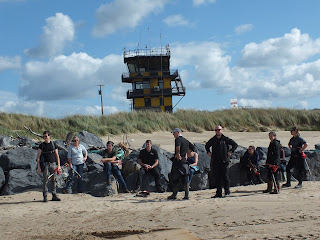With the evenings drawing in it makes the opportunity to see our shyer wildlife a little easier, so it was I joined a group of 19 wildlife seekers with Outdoor Recreation Service rangers Ollie and Scott, for a late evening/night-time wander around Pembrey Country Park.
We were on the look out for those creatures of the night such as Foxes, Badgers and of course Bats; whilst identifying the larger animals such as Badgers is easy those flighty bats need some clever equipment called "bat detectors", which turn the high pitched calls of these high fliers into sounds which we humans can hear.
 |
| Bat Detector |
With chillier evenings any bats will be trying to feed hard before making the move to hibernate for the winter, which for them is rapidly approaching. We managed to "see" with the detectors Common Pipistrelle and Soprano Pipistrelle.
We were also listening out for the distinctive calls of Tawny Owls, there are a few pairs in the Park and surrounding forest, so as there is a nationwide survey, (organised by the British Trust for Ornithology to establish the population across the UK) taking place this winter we wanted to be able to contribute, see below for more details and to join in yourselves. We only heard one Tawny Owl, it may be a little to early in the season so they haven't really started proclaiming territories
 |
| Tawny Owl |
Foxes are great opportunists and feed around the campsite, but despite some carefully laid "bait" the local foxes didn't show, but of course they have the rest of the night.
Although we didn't any Badgers, Ollie and Scott showed the group the signs to look for, such as a Badger latrine where the Badgers leave their poo in holes dug in the ground, this is not because they are fussy but because they use the latrines to make the edges of their "home range", We also saw where the Badgers had been grubbing around for "leatherjackets", the larvae of the "daddy-long-legs".
Some of the preparation by Ollie and Scott included laying a "sand trap" along likely animal routes, you could do this at home just clear an area of ground about 50cmx50cm and put down a layer of sand or sifted soil so that any animal walking over the area leaves their footprints you can then use a guide from the internet to identify which animals visit your garden: (copy and paste the link below)
https://www.rspb.org.uk/globalassets/downloads/animaltracks_tcm9-133380.pdf
|
|
Badger
At the end of the two hour walk everyone was very happy with their little adventure in the dark. Keep looking out for more events, on Facebook or Twitter, either at Pembrey Country Park or the Pembrey Burrows Nature Reserve
|
What
should you listen for?
|
Tawny Owls are
reliant on vocalisations, using them to show ownership of a breeding
territory, as well as to attract a mate and reinforce a pair bond. They
produce a variety of calls but the most common are a "hoot" and a
"kee-wick" call. Don't worry if you're not confident in
identifying their calls, there's lots of help available on our new Tawny Owl information page.
|
|
|
|








































